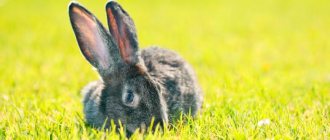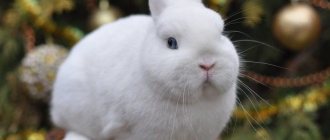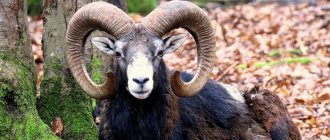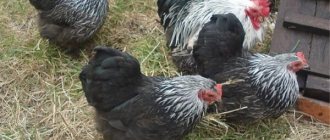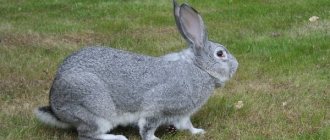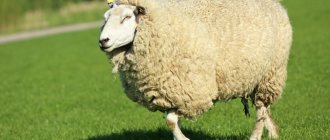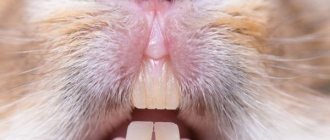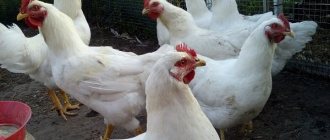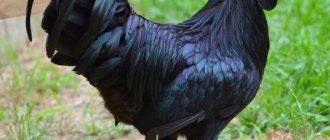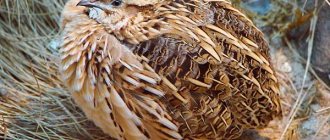Fold-eared rabbits, whose faces resemble small lambs in appearance, were described in his works by the naturalist Charles Darwin. During his extensive experience of traveling around the world, the scientist more than once admired these cute creatures. You will learn more about the Dwarf Ram rabbits in this article.
Lop-eared rabbit “Dwarf ram”
Decorative breed of rabbits “Dwarf Ram”
The breed is the result of crossing a dwarf rabbit and a French ram
Description of the breed
Photo:
Rabbits of the Fold Sheep breed are loyal and affectionate pets who will become true friends for household members if you treat them with love and care, never leave them alone and keep their home clean.
External features
Fluffy, cute rabbits do not have any common characteristics with lambs, but the name “loop-eared sheep” was received by the animals due to their short, massive head and wide forehead. The animals have a strong back of the head, serious large eyes and plump cheeks. These characteristics make the rabbit look like a cute little charmer.
Fold-eared sheep rabbits have very long ears hanging along their heads, which are their main attraction.
In adults, the length of the ears can reach 25 centimeters. The shell is turned inward, the shape of the ears resembles horseshoes. The drooping ears are slightly rounded at the tips, and their bases are thickened.
The physique of the decorative breed of fold sheep is very interesting: the body shape is cylindrical, the chest is wide, and the neck is short. The back of the body is rounded, the tail is small.
Weight
Fold rams are often shown at international and local exhibitions. By the time of their maturity, lop-eared dwarf pets weigh no more than 1-2 kilograms.
If the weight of dwarf animals is above 2 kilograms, they are not allowed to exhibit. There are anatomical differences between biologically identical males and females: females are larger than males and lack a dewlap.
Character
Fold-eared rams are responsive to the affection of people, and if treated with a friendly attitude, they are distinguished by peaceful habits and a very friendly character.
It’s not worth offending big-eared kids, thinking that they can’t stand up for themselves. Rabbits can bite an offender very painfully. It’s quite difficult for such a big-eared family pet to get along with a cat.
Rabbits are very careful animals, so adaptation to a new owner occurs gradually. Attempts to forcibly remove the little ear from the cage will only frighten him.
Huddled in the farthest corner, the animal will warily watch the human hands. It is better to open the cage door slightly, calmly waiting until the baby rabbit’s natural curiosity overcomes the feeling of fear and he wants to stick his nose into the open doorway.
You need to approach the cage with calm steps, without sudden or sweeping movements of your arms. You can interest your pet in a tasty treat by talking to him in a friendly, quiet voice.
A rabbit that is showing excessive aggressiveness should be gently pressed to the floor with your hand. The rabbit, in order to defeat its opponent, jumps on the animal's back. With such a movement, a person demonstrates that the force is on his side, forcing the pet to yield leadership rights to the owner.
In his free time, the decorative ram rabbit loves to dig trenches and holes, jump on heights, make his way through long tunnel passages to the goal, chase small bouncing and rolling objects, and tear everything that yields with his teeth.
In the absence of suitable toys, an angry pet can tear upholstery on chairs, tear off wallpaper that has slightly peeled off the wall, or tear a newspaper thrown in a hurry to shreds.
To entertain your rabbit, you can purchase or build small houses, tunnels, houses, and baskets yourself. You can move some of the toys into the eared cat’s cage. You can distract the attention of a pet that has had enough of playing with a tasty treat and slowly send it back to its cage. Things valuable to people should not be on the playing area.
Tendency to diseases
The most vulnerable places in rabbits are the ears and skin. Ear diseases can occur due to insufficient hygiene, especially for representatives of fold-eared breeds. As for skin diseases, all kinds of dermatitis (including allergic) also occur.
Colds are an item that should not be overlooked by the owner of rabbits of any breed. It is important to note that any disease in rabbits requires timely diagnosis and the help of a specialist, since improper self-treatment of a pet can lead to bad consequences.
Origin story
The characteristic external features of lop-eared rabbits attract many breeders. Slightly enlarged head cartilages and ears turned inward by the pinna give them some resemblance to rams. Fold-eared sheep were mentioned in his works by Charles Darwin, who more than once encountered unique species of plants and animals in his travels.
In the 18th century, when crossing rabbits of the dwarf breed and French lop-eared rabbits, dwarf lop-eared ram rabbits were born. In 1950, Dutch breeders developed the first dwarf breeds. The world learned about a new interesting breed of rabbits 2 years later, after which the rapid conquest of lop-eared lambs in European countries began.
Only in 1997 did this breed become known in Russia. The first nurseries of this breed were just beginning to appear in large Russian cities. In Europe and the USA during these years, fold-eared rams were already bred with all their might.
Breeders encountered some difficulties at the beginning of their experiments. The ears of a small dwarf ram do not differ in massiveness and length. For this reason, these individuals had them standing upright rather than hanging.
Painstaking work and thorough research helped achieve the desired result. As soon as the age of the dwarf rabbit approaches 12 weeks, the ears that stubbornly stick out to the sides and upwards begin to lie along the head.
Sometimes this can happen in one ear first, and then in the other a few days later. During this period, pets look a little comical, resembling naughty pranksters in appearance.
Possible health problems
Like any living creatures, lop-eared rabbits are susceptible to various diseases. Myxomatosis is considered one of the most common ailments. It is transmitted by external parasites and cannot be treated. An infected animal refuses to eat, its eyelids swell, and its body becomes covered with painful blisters. A week later the animal dies.
Another common disease that affects decorative rabbits is coccidiosis. Infection occurs through parasites transmitted through feces. The disease is accompanied by refusal to eat, weakness and bloating. Treatment should be started immediately after the first symptoms appear. Otherwise, the risk of infection of other internal organs increases significantly.
Also, decorative rabbits are prone to urinary dermatitis, characterized by inflammation and redness of the skin. This disease causes hair loss on the hind legs and groin area. Steroid drugs are usually used as treatment.
One of the most dangerous health problems is viral hemorrhagic disease, which is fatal. An infected animal's lips turn blue, its body temperature rises, its breathing slows down, and bleeding from the nose and mouth begins.
Breed varieties, color
In terms of external and qualitative characteristics, the varieties of the lop-eared sheep breed are very different:
- Meissen is a rare breed found in Germany;
- French - has become widespread in all countries;
- English - the owner of tiny front paws and large ears;
- plush - a rabbit with short, thick and soft hair;
- fleecy - distinguished by long hair;
- Dwarf and Dutch are the smallest breeds that live primarily in domestic conditions.
Valuable “coat”, high quality meat and attractive appearance are characteristic of all these breeds. The coat of animals is characterized by a wide variety. Plain white, black, gray, brown coat tones are often diluted with spots of a different color or tan marks.
Vaccination
Even if your lop-eared rabbit (decorative) does not leave the apartment, it needs to be vaccinated regularly. He is required to be given a vaccine against viral hemorrhagic disease and myxomatosis. Rabies vaccination should only be done if you plan to take your pet abroad.
The first vaccination is carried out no earlier than one and a half months of age and only when the animal’s weight reaches 1.5 kilograms. As a rule, the animal is given a complex vaccination against two ailments at once. Otherwise, a drug against myxomatosis is first administered, and after a week and a half - against a viral hemorrhagic disease. The next vaccination is given after three months. In the future, scheduled vaccinations are carried out once every six months.
Price
You cannot buy a “rabbit in a poke”. Before purchasing, the animal must be carefully examined:
- A healthy pet should have a cold and wet nose;
- the eye sclera should be shiny and clean;
- Frequent scratching and matted fur may indicate fleas;
- An animal that constantly licks the anus and tries to sit on the floor with its backside may be infected with worms;
- Diseases of the internal organs may be indicated by cloudy eyes, protruding bones, and an empty, sagging abdomen;
- Bald spots on the body indicate infection with lichen.
The price of a lop-eared ram rabbit varies depending on the pedigree, beauty and rarity of the breed. An ornamental animal without a pedigree costs from 1 to 2 thousand rubles. A pet-class lop-eared cat costs on average from 1 to 2.5 thousand rubles.
If the owners intend to breed a certain breed, it is necessary to purchase a breed-class rabbit-ram, for which they will have to pay from 2 to 4 thousand rubles.
Handsome men with pedigree displayed at exhibitions (show class) are valued at 3-5 thousand rubles. Prices for beautiful and very rare breeds, for example, Dutch Folds, can reach up to 8 thousand rubles.
The purchase should be made during the period when wool does not grow. This will allow you to carefully examine the coat for bald spots.
Selection rules
The dwarf ram must be chosen correctly. To do this, you need to know the basic nuances of this type.
Signs of purebredness
It is not so difficult to distinguish a healthy and purebred rabbit of the “Dwarf Ram” breed from a “fake” one. The most common signs of purebredness:
- shiny and thick coat;
- clean eyes, without crusts and inflammation;
- flat ears, the length of which should reach from 24 to 28 cm;
- straight and white teeth;
- a good appetite;
- strong and proportionate physique.
Signs of culling
If, when choosing a rabbit, you notice at least one of these signs, refuse to buy:
- dull, matted coat with an unpleasant odor or bald spots;
- eyes water, redness and inflammation are visible;
- incorrect length or shape of ears;
- uneven or partially missing teeth covered with a layer of plaque.
- absolute non-contact, lethargy, apathy;
- the presence of purulent discharge from the eyes and nose;
- excessively frequent, improper breathing of the animal.
An overview of the Dwarf Ram rabbit breed is presented by the breeder in the video below:
Owner reviews
The dwarf sheep is widespread throughout the world. It is perfect for keeping in a family. Children over 10 years old can communicate with the animal independently. When getting a rabbit for a small child, you need to control it so that it does not cause injury to this animal.
Most owners note the proud disposition of fluffies. Despite their modest size, they are very active and require a lot of attention.
The undoubted advantages of keeping a dwarf lop-eared sheep rabbit include:
- the animal is harmless, cute and fluffy;
- does not require constant washing;
- Rabbit food is inexpensive;
- is easy to train to the tray;
- With good care, it lives for about 10 years.
The most common disadvantages of keeping rabbits at home are:
- frequent mood swings;
- shedding every few months;
- in some cases may cause allergies in children;
- require constant attention of the owner;
- may have a slight odor.
Offspring
Female rabbits are highly fertile. Females feed babies up to 2 months of age. An offspring of 8-10 rabbits is considered normal.
Important! Babies are born with long ears pressed to the head. Tenacious, survive without specific conditions or additional care. Life expectancy is up to 10 years.
Breeding
Breeding dwarf fold rabbits is not difficult. Starting from 6 months of age, rabbits can reproduce safely. Fold rams are not particularly fertile. The female carries the rabbits for 28-36 days. With proper care, female rabbits can produce 6-7 rabbits in one litter.
A pregnant rabbit needs to be provided with maximum care. You need to keep the cage clean and give the animal more protein-rich, nutritious food.
Fresh, clean water is important for the female; it is recommended to give low-fat homemade cottage cheese and a hard-boiled egg once a day. In order for a mother rabbit to feed her babies for a long time, you need to disturb the animal as little as possible.
Sterilization and castration
At the onset of puberty, the ram rabbit begins to mark its territory and becomes restless and restless. Games with children are no longer interesting for the eared boy.
For females, the solution to the problem is sterilization, and for males, castration. After the operation, the ram becomes peaceful and calm. He is sleeping well, is interested in play again, and has a healthy appetite.
Starting from 4 months of age, females can be sterilized, but, according to many veterinarians, it is better to postpone the operation until 6 months of age, when the animal’s body becomes stronger and more mature and recovers faster after surgery.
The best age for castration of a male is 3.5-5 months. Experts do not give a definite answer as to whether it is possible to operate on individuals who have reached the age of 1-3 years. Most are inclined to believe that the operation is much more difficult for pets in this case. Before carrying out it, you must pass all the necessary tests and check the condition of the internal organs.
The rabbit is sick, what should I do?
Some rabbit diseases are indicated by the following symptoms:
- The rabbit's fur stops shining and looks unhealthy.
- The animal does not eat anything at all, does not even look at its most beloved hay and grain.
- The lop-eared rabbit is not interested in anything, he does not pay attention to anything or anyone.
- The animal has a very high temperature.
If your pet has all of these symptoms listed above, then you should contact your nearest veterinary clinic as soon as possible.
To calm the animal down a little and not shake from the temperature, place ice wrapped in a cloth on the rabbit's ears.
To prevent your beloved pet from getting sick, always watch him, keep his cage clean, and don’t leave him alone for a long time. Then the animal will respond to you with love and devotion.
Feeding
The rabbit's diet should be nutritious, complete and varied:
- Among vegetables, the ram prefers potatoes, broccoli, carrots; you should not feed him potato tops, tomatoes, beets, white cabbage and cauliflower;
- slightly dried and fresh meadow grass, dandelion, nettle will be a good source of vitamins in the summer;
- oats and wheat are suitable for grain crops;
- In winter, a fold-eared ram will like an armful of dry, fragrant herbs.
For rabbits, the main food is hay and nutritious grain mixtures. Before 6 months of age, you should not treat your baby to raw vegetables and fresh herbs, because the delicate digestive tract is not yet ready to absorb fiber and coarse fibers.
A grown rabbit can be given vegetables, fruits and green grass daily in small quantities. There should always be hay in the cage - a source of vital substances for the rabbit.
Oats, wheat, and crackers can be given as solid food, but in very moderate quantities. Rabbits should not be given dairy or meat products. Pets can sometimes be given milk for up to 2.5 months. There should always be standing, clean water in the cage. A mineral stone sold in pet stores should be attached to the wall of the cage.
Housing
Domestic lop-eared rabbits love to live in spacious cages. This is one of the conditions for their proper maintenance. The cage must have a drinking bowl with clean water and a feeder. It is necessary to provide the animal with sufficient space for movement. These are the conditions that will be ideal for keeping lop-eared animals.
Recommendation! The floor in the cage should be solid and without protrusions, as this can injure the animal.
The cage should be placed in an area of the room where direct rays of the sun do not fall. There should also be no drafts in the room. These factors can negatively affect your pet's health.
Care and maintenance
By nature, fold-eared dwarf baby rams are rodents, so it is not at all surprising that they constantly need to chew something.
Rabbits will mercilessly tear apart wires that are not removed to a safe distance in the house. Eared pets can receive an electric shock at any time.
The permanent “place of residence” of a dwarf lop-eared ram will be a cozy, spacious cage that meets the following requirements:
- Dimensions no less than 0.7x0.5 meters.
- It is advisable to arrange a “house” in the cage - a safe shelter for your pet, in which he will feel completely protected.
- The location of the cage should be selected very carefully. It should be ventilated, but without cold drafts, well lit.
- Dwarf rams are quite clean by nature, so they will choose a corner for the toilet, in which you need to place a tray. Designed for cats is quite suitable for this purpose. You can use a special triangular corner tray.
- To prevent your pet from throwing cups in different directions and clinging to them with his paws, it is better to attach a drinking bowl with water to the wall of the cage, and use heavy ceramic dishes for the feeder. Moreover, no matter how much he wants, the baby will not be able to chew on it.
- It is advisable to let the rabbit out of the cage at least once a day for several hours so that it can stretch its legs.
- Use a special nail clipper to remove sharp claws so that the furniture in the house is not scratched.
The cleanliness of the feeders must be constantly monitored and the availability of clean water must be constantly taken care of. Animals eat frequently; the work of their gastrointestinal tract is based on pushing food through the arrival of new portions.
Pets can eat and defecate at the same time. For convenience, a feeder with hay is placed next to the tray. Well-dried wood shavings or finely shredded newsprint without printing ink are the best bedding materials.
Folds take care of the condition of their fur themselves, so they are bathed very rarely. The main thing is not to forget to clean their cage regularly and provide the animal with a clean tray every day. A ram demanding cleanliness will not go into a dirty litter box.
How to tame
Despite their friendliness, most rabbits are proud creatures. They believe that they can cope with everything that surrounds them on their own, so they do not like to be picked up or taught. Do this: open the cage, let the rabbit out and follow him. If the rabbit does not want to leave its shelter, it means that it is very scared, so the cage now acts as an intercessor house for it.
Want to see how the rabbit is doing in the cage? Approach it carefully. If the animal wants, it will come out and approach you. In order for your rabbit to trust you, always approach him with some kind of treat. If the rabbit is very angry and intends to bite you, do not hit him, but lightly press his head to the floor: this way he will understand that you are the master of the house where he lives. By their nature, rabbits do not tolerate competition, so they easily jump on their “guest”’s back, thereby indicating that he is the master here.
It is very difficult to communicate with a fold-eared sheep. It's as if you are talking to a small child, trying to explain something to him, but he doesn't listen. Do not try to say anything to the animal with shouting and anger, in a commanding tone. Sit quietly next to him, talk to him quietly and without emotional overtones. This way the animal will definitely hear you.
The rabbit needs special care. His nails should be cut as needed. To make it easier to care for your pet’s nails, buy special tweezers that will prevent you from accidentally touching a vessel on the animal’s paws.
Monitor your rabbit's behavior. If he plays, jumps, and is active a lot, then everything is fine with him. However, if the animal has not wanted to eat anything for a long time, sits in a cage and sleeps constantly, and its fur has become dull, it means that your pet is sick.
Productive qualities
As a rule, sheep rabbits are bred for decorative purposes. However, these animals have excellent productive qualities. One of the main advantages of the breed is the precocity of rabbits and rapid weight gain.
At the age of 5–7 months, when rabbits reach sexual maturity, they already weigh from 1.5 to 3 kg, with the greatest growth dynamics observed up to 3 months. The final height and weight of animals are formed at the age of 6–8 months.
Of course, the rate of body weight gain is considered one of the most important productive characteristics for farmers breeding sheep and rabbits for the purpose of selling meat products. With increased and high-quality nutrition, some individuals are able to gain weight up to 10 kg.
Important! Rams
are quite voracious rabbits, so if keeping these animals has a decorative purpose, then it is very important for breeders to monitor their diet.
Obesity can provoke health-threatening diseases, in particular, damage to the liver, heart, and disruption of the digestive tract. In addition to high meat performance, lamb rabbits can boast of high-quality and valuable fur. The animal's skin is soft, dense, the wool is thick and silky, with a beautiful uniform color.
Temperament
Fold rabbits are distinguished by their excellent character, calm temperament, and easy-going disposition. They are very sociable, sociable, playful, easily get used to their owner and adapt to new conditions.
Their playful nature especially appeals to children. However, it is not recommended to have an animal if there are small children in the house, since they can cause pain to the rabbit, and he, in turn, is able to respond with aggression or even bite. In other cases, these animals are friendly and quickly make contact.
Many people wonder whether these rabbits live alone or prefer company. Animals can live well alone, although they do not mind sharing housing with other relatives. Usually, lambs quickly find a common language with each other and, when they get to know each other well, form close bonds and continue to be friends until the end of their lives.
You will be interested to know which breeds of rabbits are classified as meat-skin rabbits - butterfly, gray and white giant, chinchilla, and which breeds are classified as meat - Strokach, Flanders, Californian.
Appearance
The Netherland or Dutch Fold rabbit is the smallest of all sheep. It weighs only 1.5-2 kg and is up to 25 cm long.
The appearance of a typical representative of a decorative breed should fall under the following description:
- The head is wide, with a short blunt nose, a pronounced nape, a protruding forehead and large eyes.
- The ears are long, thick at the base and rounded at the tips. They are turned with their shells inward and hang down on both sides of the muzzle.
- The body is compact, cylindrical, with a short neck, massive chest, spherical back and short tail.
- The coat is short and soft. The color is blue, opal, red, white, cheetah, chinchilla, black and even sable.
French ram rabbit
Character
Unlike other relatives, they are calm. They quickly adapt to the human environment. They are friendly and love children. Many people buy such pets for children, who develop faster when playing with them.
Rabbits with drooping ears are less timid than those with erect ears. Drooping ears significantly muffle surrounding sounds.
The coat is smooth and therefore does not require special care. Specialized stores sell combs that you can use to brush your pet once a week.
